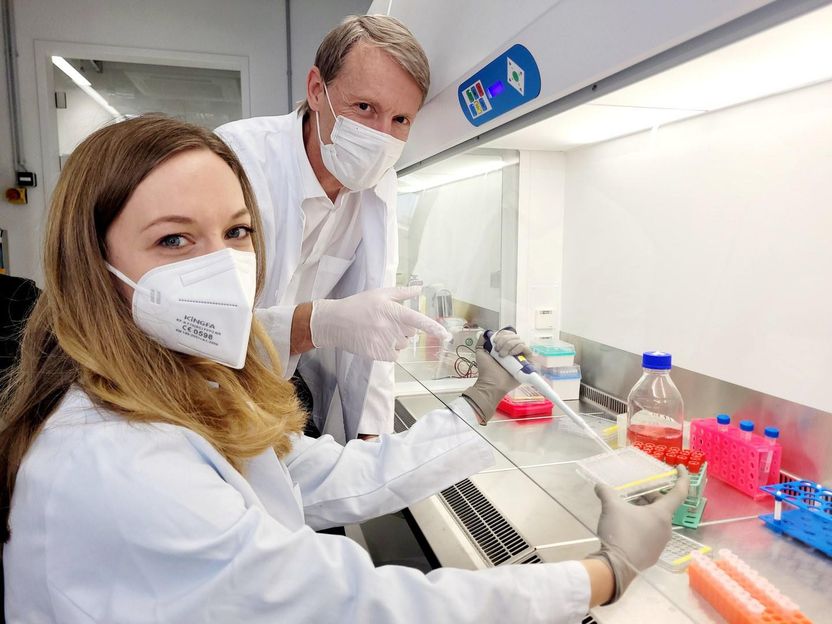Scripps Research Scientists Identify Blood Component that Turns Bacteria Virulent
Findings May Provide Basis for New Drug Development
Scientists from the Scripps Research Institute have discovered the key chemical that signals Bacillus anthracis, the bacterium that causes anthrax, to become lethal. This finding opens up new avenues of exploration for the development of treatments for bacterial infections. The study was published in PLoS Pathogens.
The Scripps Research scientists identified bicarbonate, a chemical found in all body fluids and organs that plays a major role in maintaining pH balance in cells, as providing the signal for Bacillus anthracis to unleash virulence factors. Without the presence of the bicarbonate transporter in the bloodstream, the scientists found, the bacteria do not become virulent.
Scientists have known for some time that bicarbonate is implicated in many diseases, but controversy has existed about whether bicarbonate, carbon dioxide, or some combination of these two molecules are responsible for triggering bacterial pathogenesis. This study confirms, for the first time, that it is indeed bicarbonate, rather than carbon dioxide, that signals the gram-positive B. anthracis to become virulent. This finding also is significant because other pathogenic bacteria such as Streptococcus pyogenes, Escherichia coli, Borrelia burgdorferi, and Vibrio cholera have bicarbonate transport pathways similar to B. anthracis and thus are likely to have similar virulence triggering mechanisms.
Gram-positive bacteria are the major culprits driving the increase of community and hospital acquired bacterial infections. The Centers for Disease Control and Prevention estimates that as many as 10 percent of all patients, or about 2 million people, contract hospital acquired infections each year. These bacteria are often resistant to multiple antibiotics, making the problem a growing public health concern and the need for new antibacterial treatment more urgent. Now, the bicarbonate transporter pathway may be investigated as a potential new target for drug intervention.
"How a bacterium recognizes signals in the host that trigger pathogenesis mechanisms, and the nature of the mechanisms necessary to develop pathogenesis, remain poorly understood," said Scripps Research Associate Professor Marta Perego, Ph.D., who conducted the study with Scripps Research postdoctoral fellow Adam Wilson, Ph.D., and colleagues. "We have identified an essential component for the induction of virulence gene expression in response to host bicarbonate levels and have used this finding to learn more about the extracellular and intracellular signals controlling virulence."
Perego's latest discovery builds on her lab's expertise in the study of bacterial virulence signaling and in the regulatory networks responsible for pathogenicity in other gram-positive bacteria. Her interest in bicarbonate transport pathways as bacteria virulence signaling mechanisms grew out of an early observation that growth of B. anthracis in carbon dioxide and sodium bicarbonate strongly induced toxin production in the laboratory setting. The mechanism behind this observation, however, was never uncovered.
In their current study, the Perego lab identified a previously unknown ATP-binding cassette transporter (ABC-transporter) — which is identified by the gene number BAS2714-12 — that was shown to be essential to transporting bicarbonate. As a group, ABC-transporters use the energy of ATP hydrolysis to transport various substrates across cellular membranes. In this case, when the genes that code for the BAS2714-12 ABC transporter were deleted, the rate of bicarbonate uptake inside the cell greatly decreased, induction of toxin gene expression did not occur, and virulence in an animal model of infection was abolished. Elimination of carbon dioxide production within the bacterial cell had no effect on toxin production, suggesting that CO2 activity is not essential to virulence factor induction and that bicarbonate, not CO2, is the signal essential for virulence induction.
"In light of these findings, investigation of bicarbonate regulation and transport should be of much greater significance to a large number of pathogenic organisms," Perego said.
Most read news
Other news from the department science
These products might interest you

Hahnemühle LifeScience Catalogue Industry & Laboratory by Hahnemühle
Wide variety of Filter Papers for all Laboratory and Industrial Applications
Filtration Solutions in the Life Sciences, Chemical and Pharmaceutical Sectors

Hydrosart® Ultrafilter by Sartorius
Efficient ultrafiltration for biotech and pharma
Maximum flow rates and minimum protein loss with Hydrosart® membranes

Hydrosart® Microfilter by Sartorius
Hydrophilic microfilters for bioprocesses
Minimal protein adsorption and high flow rates

Sartopore® Platinum by Sartorius
Efficient filtration with minimal protein adsorption
Reduces rinsing volume by 95 % and offers 1 m² filtration area per 10"

Polyethersulfone Ultrafilter by Sartorius
Reliable filtration with PESU membranes
Perfect for biotechnology and pharmaceuticals, withstands sterilisation and high temperatures

Polyethersulfone Microfilter by Sartorius
Biotechnological filtration made easy
Highly stable 0.1 µm PESU membranes for maximum efficiency

Sartobind® Rapid A by Sartorius
Efficient chromatography with disposable membranes
Increase productivity and reduce costs with fast cycle times

Get the life science industry in your inbox
By submitting this form you agree that LUMITOS AG will send you the newsletter(s) selected above by email. Your data will not be passed on to third parties. Your data will be stored and processed in accordance with our data protection regulations. LUMITOS may contact you by email for the purpose of advertising or market and opinion surveys. You can revoke your consent at any time without giving reasons to LUMITOS AG, Ernst-Augustin-Str. 2, 12489 Berlin, Germany or by e-mail at revoke@lumitos.com with effect for the future. In addition, each email contains a link to unsubscribe from the corresponding newsletter.
Most read news
More news from our other portals
Last viewed contents

Blood stem cells in a rush -- velocity determines quality

New genetic mechanism explains history's tallest giants - International team explains genetic causes of X-linked acrogigantism (X-LAG)

Ilmac 2023 kicks off in Basel with new highlights

Cycling between a healthy and unhealthy diet has significant health effect - Diet cycling impacts spatial memory: rat study
Alchemia: First granting of antibody patents - Key patent granted in Japan

Strategic peptide purification - Practical and theoretical aspects of method development using reversed phase chromatography























































